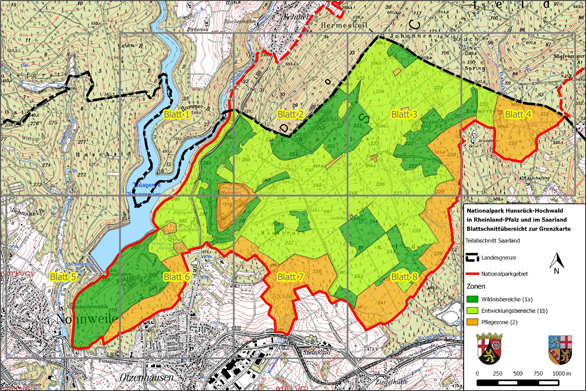Foto: K. Funk
Zum Kartendienst "Nationalpark Hunsrück-Hochwald (saarl. Teil)"
Zum Kartendienst "Nationalpark Hunsrück-Hochwald (Gesamtfläche)"
Rheinland–Pfalz und das Saarland haben durch einen Staatsvertrag einen gemeinsamen Ländergrenzen überschreitenden Nationalpark in einer Gesamtgröße von ca. 10.000 ha eingerichtet. Die entsprechenden Gesetze wurden durch die Landtage des Saarlandes und des Landes Rheinland-Pfalz Ende 2014 bzw. Anfang 2015 verabschiedet. Rund 985 Hektar des Nationalparks liegen innerhalb des Gebietes der Gemeinden Nohfelden und Nonnweiler. Dieses im Saarland liegende Teilgebiet ist in einer Gliederungskarte im Maßstab 1: 10.000 und einer Grenzkarte (in 8 Blattschnitten) im Maßstab 1: 2.000 dargestellt.
Aus der Grenzkarte ist das Gebiet zu ersehen, für das die Unterschutzstellung als Nationalpark nach § 24 BNatSchG im Saarland gültig ist. Dieses Gebiet ist untergliedert in die Naturzone, die sich in eine Naturzone 1a (Wildnisbereiche, dunkelgrün) und eine Naturzone 1b (Entwicklungsbereiche, hellgrün) unterteilt. Diese unterschiedliche Farbgebung soll sozusagen den unterschiedlichen "Wildnisgrad" dieser beiden Gebiete wiedergeben. In der Naturzone 1a (Wildnisbereiche) ist der Wald bereits vollständig aus der forstlichen Bewirtschaftung genommen und sich selbst überlassen. In der Naturzone 1b (Entwicklungsbereiche) soll der Wald durch Entnahme der nicht standortheimischen Arten (insbesondere Nadelbäume) noch so umgebaut werden, dass sich die von Natur aus standorttypischen Waldgesellschaften dort einstellen können. Insgesamt ist ein maximaler Zeitrahmen von 30 Jahren gegeben, damit sich die Naturzone 1b in die Naturzone 1a entwickeln kann.
Die Naturzone 1a soll dann 75 % der Gesamtfläche des Nationalparks ausmachen, um die internationalen Kriterien der IUCN für Nationalparks zu erfüllen. Auf dieser Fläche darf Natur dann Natur sein.
Die restliche Fläche mit ihrem Anteil von rund 25 % ist der Pflegezone 2 zugeordnet. Diese soll die Naturzone vor negativen Einflüssen aus den benachbarten Gebieten schützen. In dieser Zone ist die Durchführung von Pflege- und Entwicklungsmaßnahmen, die auch der Versorgung der Bürgerinnen und Bürger mit Brennholz dienen, möglich. Da in der Grenzkarte und dem entsprechenden Kartendienst die jeweiligen Flurstücke zu identifizieren sind, können Eigentümerinnen und Eigentümer genau feststellen, ob und gegebenenfalls inwieweit sie durch das Vorhaben betroffen sind.
Die Grenzkarte und Gliederungskarte sind begründend für den Nationalpark Hunsrück-Hochwald (saarländischer Teil).
Das Regelwerk zum Nationalpark Hunsrück-Hochwald umfasst:
Das saarländische Gesetz über die Zustimmung zu dem Staatsvertrag zwischen den Ländern Rheinland-Pfalz und Saarland über die Errichtung und Unterhaltung des Nationalparks Hunsrück-Hochwald kann hier ( Staatsvertrag) eingesehen werden.
Nationalpark Hunsrück-Hochwald
Der länderübergreifende Nationalpark Hunsrück-Hochwald bietet eine einmalige Natur – geprägt von alten Buchenwäldern, einsamen Mooren, lebendigem Totholz, steinigen Rosselhalden und bunten Arnikawiesen. "Natur Natur sein lassen" ist das Credo des Nationalparks. Gemeint ist damit das Zulassen natürlicher Prozesse, in die wir Menschen bewusst nicht gestaltend eingreifen. Die große Fläche eines Nationalparks gewährleistet diese Entwicklung.
Der saarländische Teil umfasst zwar nur 10 Prozent des gesamten Parks, aber der hat es in sich. Der keltische Ringwall ist in seinen Ausmaßen ein ganz besonderes Relikt unserer antiken Vorfahren und ein Publikumsmagnet für Besucher. Der Eisener Wald weist eine sehr hohe Naturschutzwürdigkeit aus und ist als Fauna-Flora-Habitat- und Vogelschutzgebiet Teil des europäischen Schutzgebietssystems Natura 2000.
Buchstäblich ins Auge fallen im Nationalpark drei herausragende Höhe(n)punkte:
An drei Nationalpark-Toren (im Saarland: Keltenpark Otzenhausen) werden Besucher*innen empfangen und informiert.
Die Gliederungskarte liefert im Maßstab 1: 10.000 einen ersten Überblick über die Außengrenze und die innere Gliederung des Nationalparks Hunsrück-Hochwald.

Aus der Grenzkarte im Maßstab 1: 2.000 und dem entsprechenden Kartendienst können die jeweiligen Flurstücke hinsichtlich ihrer Lage im Nationalpark eindeutig verortet und identifiziert werden. Die Blattschnittübersicht soll die Orientierung erleichtern und einen geeigneten Suchhinweis liefern.

Ministerium für Umwelt, Klima, Mobilität, Agrar und Verbraucherschutz
Referat D/3 "Landschaft und Fischerei"
Dr. Tanja Helmes
E-Mail-Kontakt
Telefon: +49 681 501-4355



